On This Page:
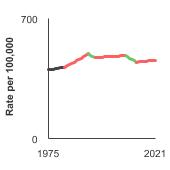
Background
Cancer incidence is typically measured as the number of new cases each year for every 100,000 people (for sex-specific cancers, people of the same sex serve as the denominator) and age-adjusted to a standard population to allow comparisons over time.
In 2024, nearly half of all new cancer cases are expected to be cancers of the prostate, breast, lung, and colon and rectum. According to American Cancer Society projections, about 2,001,140 new cases of cancer are expected to be diagnosed in 2024, including 299,010 cases of prostate cancer, 313,510 cases of breast cancer, 234,580 cases of lung and bronchus cancer, and 152,810 cases of colorectal cancer.
Measure
Incidence rate: the observed number of new cancer cases per 100,000 people per year, adjusted for age and cancer case reporting delays and based on data from approximately 10 percent of the U.S. population.
Delay adjustment: a method of estimating delayed reporting of incident cases and then adjusting rates to account for this delay.
Trend lines: calculated from the underlying rates using the Joinpoint Trend Analysis Software.
The 2020 incidence rate is displayed but not used in the fit of the trends line(s). Impact of COVID on SEER Incidence 2020 data.
Data Source
SEER Program, National Cancer Institute, 1975–2021.
Healthy People 2030 Target
There are no Healthy People 2030 targets for cancer incidence.
Healthy People 2030 is a set of goals set forth by the Department of Health and Human Services.
Trends and Most Recent Estimates
All Cancer Sites Combined
By Sex
| Overview Graph | Detailed Trend Graphs | Most Recent Estimates (2021) | |
|---|---|---|---|
| Rate per 100,000 | 95% Confidence Interval | ||
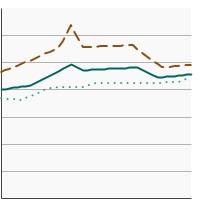  |
Both Sexes |
461.4 | 459.0 - 463.9 |
Male |
492.8 | 489.2 - 496.4 | |
Female |
443.2 | 439.9 - 446.5 | |
By Race/Ethnicity
| Overview Graph | Detailed Trend Graphs | Most Recent Estimates (2021) | |
|---|---|---|---|
| Rate per 100,000 | 95% Confidence Interval | ||
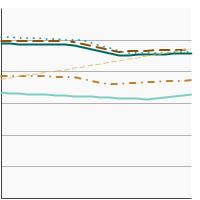  |
All Races |
458.3 | 457.3 - 459.3 |
Non-Hispanic White |
467.5 | 466.3 - 468.6 | |
Non-Hispanic Black |
461.7 | 458.6 - 464.7 | |
Hispanic |
372.8 | 370.5 - 375.0 | |
Non-Hispanic Asian/Pacific Islander |
329.7 | 326.8 - 332.5 | |
Non-Hispanic American Indian/Alaska Native |
477.9 | 459.1 - 497.2 | |
Top 4 Cancer Sites
Comparison of Top Cancer Sites
| Overview Graph | Detailed Trend Graphs | Most Recent Estimates (2021) | |
|---|---|---|---|
| Rate per 100,000 | 95% Confidence Interval | ||
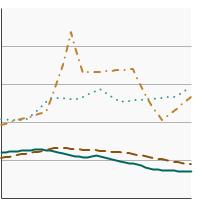  |
Colon and Rectum |
35.8 | 35.2 - 36.5 |
Lung and Bronchus |
43.7 | 43.0 - 44.4 | |
Female Breast |
144.6 | 142.7 - 146.5 | |
Prostate |
131.4 | 129.6 - 133.3 | |
Colon and Rectum Cancer by Sex
| Overview Graph | Detailed Trend Graphs | Most Recent Estimates (2021) | |
|---|---|---|---|
| Rate per 100,000 | 95% Confidence Interval | ||
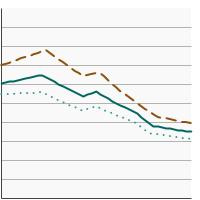  |
Both Sexes |
35.8 | 35.2 - 36.5 |
Male |
39.9 | 38.9 - 41.0 | |
Female |
32.2 | 31.3 - 33.1 | |
Colon and Rectum Cancer by Race/Ethnicity
| Overview Graph | Detailed Trend Graphs | Most Recent Estimates (2021) | |
|---|---|---|---|
| Rate per 100,000 | 95% Confidence Interval | ||
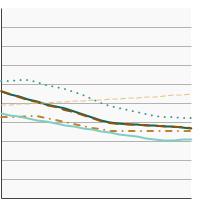  |
All Races |
37.5 | 37.2 - 37.8 |
Non-Hispanic White |
37.1 | 36.8 - 37.4 | |
Non-Hispanic Black |
41.9 | 41.0 - 42.8 | |
Hispanic |
35.3 | 34.6 - 36.0 | |
Non-Hispanic Asian/Pacific Islander |
31.3 | 30.4 - 32.2 | |
Non-Hispanic American Indian/Alaska Native |
58.6 | 52.1 - 65.6 | |
Lung and Bronchus Cancer by Sex
| Overview Graph | Detailed Trend Graphs | Most Recent Estimates (2021) | |
|---|---|---|---|
| Rate per 100,000 | 95% Confidence Interval | ||
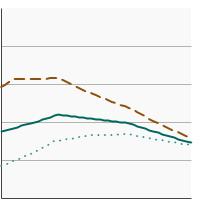  |
Both Sexes |
43.7 | 43.0 - 44.4 |
Male |
46.7 | 45.6 - 47.8 | |
Female |
41.6 | 40.6 - 42.6 | |
Lung and Bronchus Cancer by Race/Ethnicity
| Overview Graph | Detailed Trend Graphs | Most Recent Estimates (2021) | |
|---|---|---|---|
| Rate per 100,000 | 95% Confidence Interval | ||
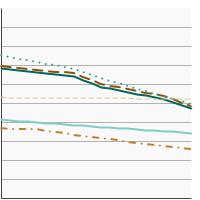  |
All Races |
46.9 | 46.6 - 47.3 |
Non-Hispanic White |
48.1 | 47.8 - 48.5 | |
Non-Hispanic Black |
48.6 | 47.6 - 49.6 | |
Hispanic |
25.5 | 24.9 - 26.2 | |
Non-Hispanic Asian/Pacific Islander |
33.5 | 32.6 - 34.4 | |
Non-Hispanic American Indian/Alaska Native |
57.5 | 51.1 - 64.3 | |
Female Breast Cancer by Race/Ethnicity
| Overview Graph | Detailed Trend Graphs | Most Recent Estimates (2021) | |
|---|---|---|---|
| Rate per 100,000 | 95% Confidence Interval | ||
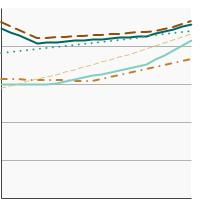  |
All Races |
137.4 | 136.6 - 138.2 |
Non-Hispanic White |
138.7 | 137.8 - 139.6 | |
Non-Hispanic Black |
131.1 | 128.9 - 133.3 | |
Hispanic |
111.1 | 109.5 - 112.7 | |
Non-Hispanic Asian/Pacific Islander |
125.5 | 123.1 - 127.9 | |
Non-Hispanic American Indian/Alaska Native |
131.0 | 117.8 - 145.2 | |
Prostate Cancer by Race/Ethnicity
| Overview Graph | Detailed Trend Graphs | Most Recent Estimates (2021) | |
|---|---|---|---|
| Rate per 100,000 | 95% Confidence Interval | ||
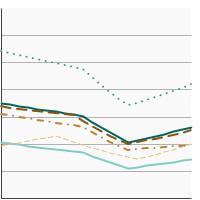  |
All Races |
128.0 | 127.2 - 128.7 |
Non-Hispanic White |
121.1 | 120.3 - 122.0 | |
Non-Hispanic Black |
209.8 | 206.6 - 213.0 | |
Hispanic |
96.3 | 94.5 - 98.1 | |
Non-Hispanic Asian/Pacific Islander |
71.3 | 69.3 - 73.3 | |
Non-Hispanic American Indian/Alaska Native |
101.5 | 88.5 - 115.8 | |
Recent Trends for Common Cancer Sites
| Overview graph | Cancer Site | Average Annual Percent Change |
|---|---|---|
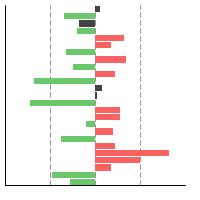  |
All Sites | 0.2 |
| Brain and ONS | -1.4* | |
| Cervix Uteri | -0.7 | |
| Colon and Rectum | -0.8* | |
| Corpus Uteri and NOS | 1.3* | |
| Esophageal Adenocarcinoma | 0.7* | |
| Esophageal Squamous Cell | -1.3* | |
| Female Breast | 1.4* | |
| Hodgkin Lymphoma | -1.0* | |
| Kidney and Renal Pelvis | 0.9* | |
| Larynx | -2.7* | |
| Leukemia | 0.3 | |
| Liver and IBD | 0.1 | |
| Lung and Bronchus | -2.9* | |
| Melanoma of the Skin | 1.1* | |
| Myeloma | 1.1* | |
| Non-Hodgkin Lymphoma | -0.4* | |
| Oral Cavity and Pharynx | 0.8* | |
| Ovary | -1.5* | |
| Pancreas | 0.9* | |
| Prostate | 3.3* | |
| Stomach | 2.0* | |
| Testis | 0.7* | |
| Thyroid | -1.9* | |
| Urinary Bladder | -1.1* | |
| * The Average Annual Percent Change (AAPC) is statistically significant. | ||
Additional Information
- Cancer Incidence Rates. National Cancer Institute.
- Common Cancer Types. National Cancer Institute.
- Learn About Cancer. American Cancer Society.
- Resources for Health Professionals. National Cancer Institute.
- Cancer Facts and Figures. American Cancer Society.
- Annual Report to the Nation on the Status of Cancer. National Cancer Institute.
- Lung cancer incidence trends among men and women – United States, 2005–2009. Henley SJ, Richareds TB, Underwood JM, et al. MMWR Morb Mortal Wkly Rep 2014;63(01):1–5.
- Invasive Cancer Incidence and Survival—United States, 2013. Henley SJ, Singh SD, King JK et al. MMWR Morb Mortal Wkly Rep. 2017:66(3):69-75.
- Cancer Statistics, 2018. Siegel RL, Miller KD, Jemal, A. CA: A Cancer Journal for Clinicians. 2018;61(01):7-30.
- SEER Cancer Statistics Review, National Cancer Institute.
- State Cancer Profiles. National Cancer Institute, and Centers for Disease Control and Prevention.
- United States Cancer Statistics: Data Visualizations. National Cancer Institute, and Centers for Disease Control and Prevention.
- United States Cancer Statistics – Interpreting Incidence Data. National Cancer Institute, and Centers for Disease Control and Prevention.
- SEER*Explorer: An interactive website that provides easy access to a wide range of SEER cancer statistics. National Cancer Institute.
- WONDER Online Databases – United States Cancer Statistics. Centers for Disease Control and Prevention.